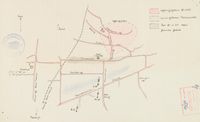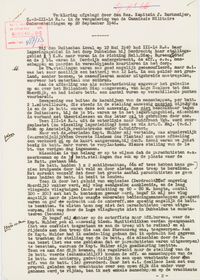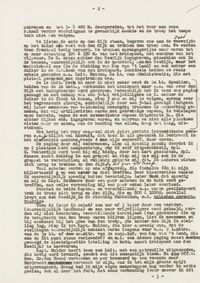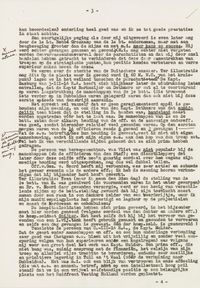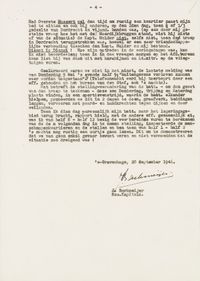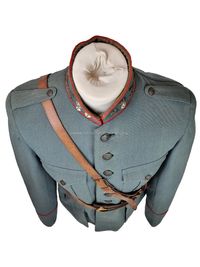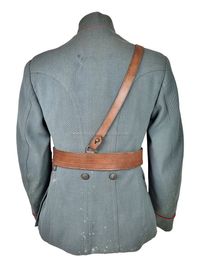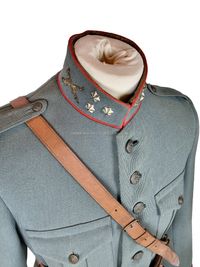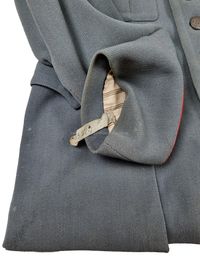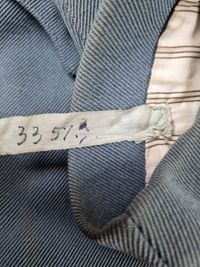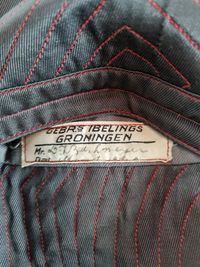Captain Barkmeijer's uniform jacket - C-2-III-14 R.A.
Below you will find the "Buitenmodel" ( private tailored ) uniform jacket of Reserve Captain J. Barkmeijer from the 3rd department of the 14th Artillery Regiment (III-14 R.A.). Captain Barkmeijer was the commander of the 2nd Battery of that unit. The entire 3rd department was equipped with ancient "12 lang staal" cannons. These guns dated back to 1878 and had a caliber of 125 mm. Each gun was operated by a piece commander and six crew members. III-14 R.A. consisted of three batteries, each with four guns. The division was initially stationed in Tul en 't Waal from early September 1939 to early April 1940. Afterwards, the department was moved to Dubbeldam. The staff of III-14 R.A. and the staff of 3-III-14 R.A. were both housed in Dordtwijck. The officers, non-commissioned officers, soldiers, and horses were distributed among various quarters in Dubbeldam. The headquarters of III-14 R.A. was located in the school on the Zuidendijk. Shortly before the 10th of May, the guns were placed in a forward position in the vicinity of the Wieldrechtse Zeedijk. The right battery under Reserve Captain W.J. Dethmers was deployed along the Blindeweg. The left battery under Reserve Captain H. Sasburg. The middle battery under Reserve Captain J. Barkmeijer was located southwest of the intersection: Schenkeldijk, Zeedijk, Oude Veerweg. The main firing direction of the department was the southern Moerdijk bridgehead. The guns were positioned in emplacements with earth walls for fragmentation protection. There was little camouflage applied on May 10, 1940. However, two of the three batteries had sentry posts equipped with Light Machine Guns. Each battery had at least one ammunition ration. It is possible that the guns were not yet accurately measured. * 1 *2
Captain Jan Barkmeijer during the events in May 1940.
Jan Barkmeijer was born on December 2, 1900, in the municipality of Achtkarspelen in Friesland. He was a dentist by profession and married Willy Staal after the war. During the mobilization, he served as a Reserve Captain in the 14th Artillery Regiment. He was the commander of the 2nd battery of the 3rd department (2-III-14 R.A.). On May 10, 1940, Captain Barkmeijer woke up to explosions in the Moerdijk area. He hurried to the barracks of the unmounted soldiers and instructed the non-commissioned officers to occupy the batteries as quickly as possible. However, the sentry posts at the batteries had already been overrun, and they had withdrawn to Zuidendijk. Meanwhile, German paratroopers had practically landed right on top of the positions of III-14 R.A. and had immediately captured the guns. After Captain Barkmeijer rode to the department office on a motorcycle, ammunition was distributed to the soldiers stationed at Stevensweg. Captain Barkmeijer then decided, with the approval of the Department Commander Captain Mulder, to retake the batteries since it had become clear that they were occupied by German paratroopers. While en route on Schenkeldijk, they came under fire. They tried to advance in a leapfrog manner along the length of the dike, resulting in several casualties, including Lieutenant Rutten from the administration.
Meanwhile, 1st Lieutenant Koch, and possibly 2nd Lieutenant Spoelder, were scouting the Schenkeldijk, Zeedijk, Oude Veerweg intersection. The Germans retaliated by throwing hand grenades over the dike. These grenades were located behind the Zeedijk and behind a culvert in the northeastern corner of the intersection. Captain Barkmeijer decided to flank the Germans with five men from behind that culvert. They came under heavy fire, and the Captain was soon wounded in the leg. Conscript Private Westerdijk attempted to remove the Captain from the line of fire. However, as he raised himself slightly to remove the Captain's boot, he was struck in the heart and killed instantly. According to the Captain, his last words were, "Oh Mother," before he died. Meanwhile, the wounded Captain remained in a ditch while the rest of the group withdrew behind the Zuidendijk. He was still under fire, as a bullet struck his binoculars. Other rounds landed only a meter away from him. Approximately three hours later, when the fire had subsided somewhat, Captain Barkmeijer was retrieved by a group of volunteers. His leg wounds were treated by the Medical Officer, Dr. van Noord, after which he was transported to a hospital in Dordrecht on a stretcher. Captain Barkmeijer survived his injuries. After being on extended leave, he later became a member of the Groningen Resistance during the war. He became the deputy commander of the Orde Dienst in Groningen District I..
On November 12, 1946, Captain Barkmeijer was awarded the Bronze Cross by Royal Decree for his military actions in Dubbeldam with III-14 R.A. On October 26, 1982, the Resistance Memorial Cross was added to his accolades. On February 17, 1988, Jan Barkemeijer passed away at the age of 87 in Groningen. *3
Photo: Anton Bohnen - Veldartillerie III-14 R.A. Tul en 't Waal & Dubbeldam 1939-1940. *3
On the left: Kapitein Barkmeijer, on the right: Private Westerdijk.
War Report May 1940 Barkmeijer - Commander 2-III-14 R.A.
409 Gevechtsarchieven - 12.5.9. Artillerie in de Groep Kil - 487013 -
Information about the commander of the 2nd battery of the IIIrd department of the 14th artillery regiment, Captain J. Barkmeijer. *4
Uniform jacket of Captain Barkmeijer - Commander 2-III-14 R.A.
This is the uniform jacket of Captain Barkmeijer, Commander of the 2nd battery of the 3rd department of the 14th artillery regiment. It is an private tailored jacket made of Ripcord fabric, which was the last type of private tailored jacket produced during the mobilization. Officers had to privately purchase their uniforms, but they were reimbursed by the government. It is important to note that it cannot be confirmed whether Captain Barkmeijer wore this specific uniform jacket on May 10, 1940. Typically, officers had multiple jackets, usually at least two. What is noticeable is that the trousers are missing, likely due to the Captain's leg injuries sustained in the war. Therefore, this may be the jacket he wore in May 1940, but it cannot be verified. The jacket was made by tailor J. Belings from Groningen during the mobilization and was later used by a drama school in Groningen after the war. There is a label with a number on the inside of the sleeve, possibly the Captain's laundry label. Inside the pocket, there is a label with his name: J. Barkmeyer, March 1940. The Ribcord uniform is undoubtedly one of the more beautiful and better quality uniforms produced during the mobilization, but it was also a very heavy uniform and not particularly suitable for field service. The jacket is worn with a Sam-Brown belt, specifically designed for officers. The stars on both sides of the collar indicate the rank of captain. The red stripes on the collar and sleeves indicate that it is an artillery uniform.
Uniform jacket of Captain Barkmeijer on a bust.
Uniformjas Kapitein Barkmeijer binnenzijde.
Kunt u ons meer informatie leveren over Kapitein Barkmeijer? Of heeft u nog andere zaken met betrekking tot de Kapitein ter aanvulling van mijn collectie? Mail dan gerust naar: Info@Dordrechtindeoorlog.nl
©2017-2025 :Https://www.Dordrechtindeoorlog.nl: ( There is a copyright on the content of this website. This content is not to be shared, duplicated or published withouth the explicit permission of the author of this website. If you have any requests you can email to: Info@Dordrechtindeoorlog.nl or look on : www.dordrechtindeoorlog.nl/termsofuseforthecontentonthiswebsite.
*1 Source: Zuidfront-Holland1940 - Vak Wieldrecht 1e fase.
*2 Source: A.Bohnen - Veldartillerie III-14-R.A. Tull en 't Waal & Dubbeldam 1939-1940.
*3 Source: Groningsearchieven.nl
*4 Source: 409 gevechtsarchieven.
*5 Source: Veldgrijs deel 4 - M.C. Farla.
